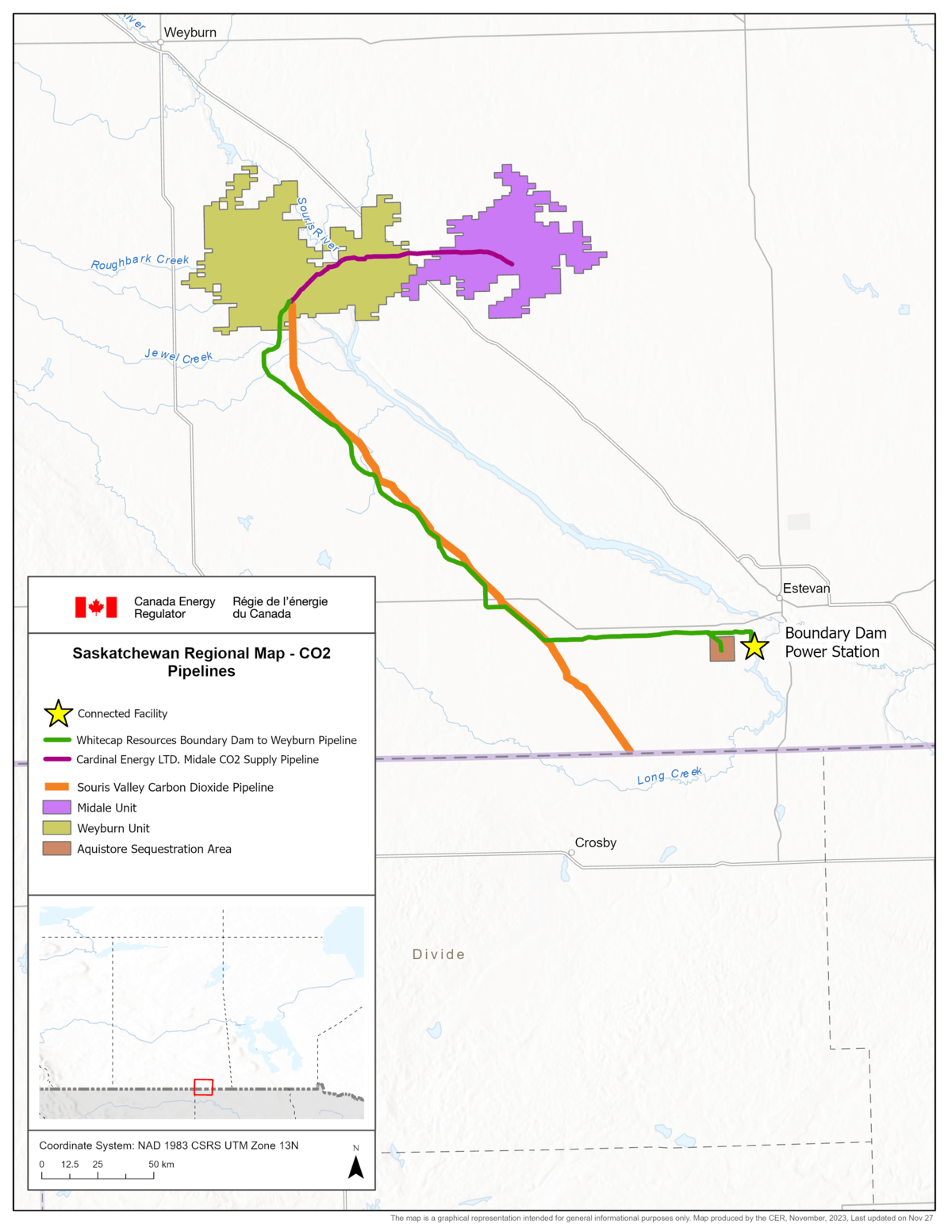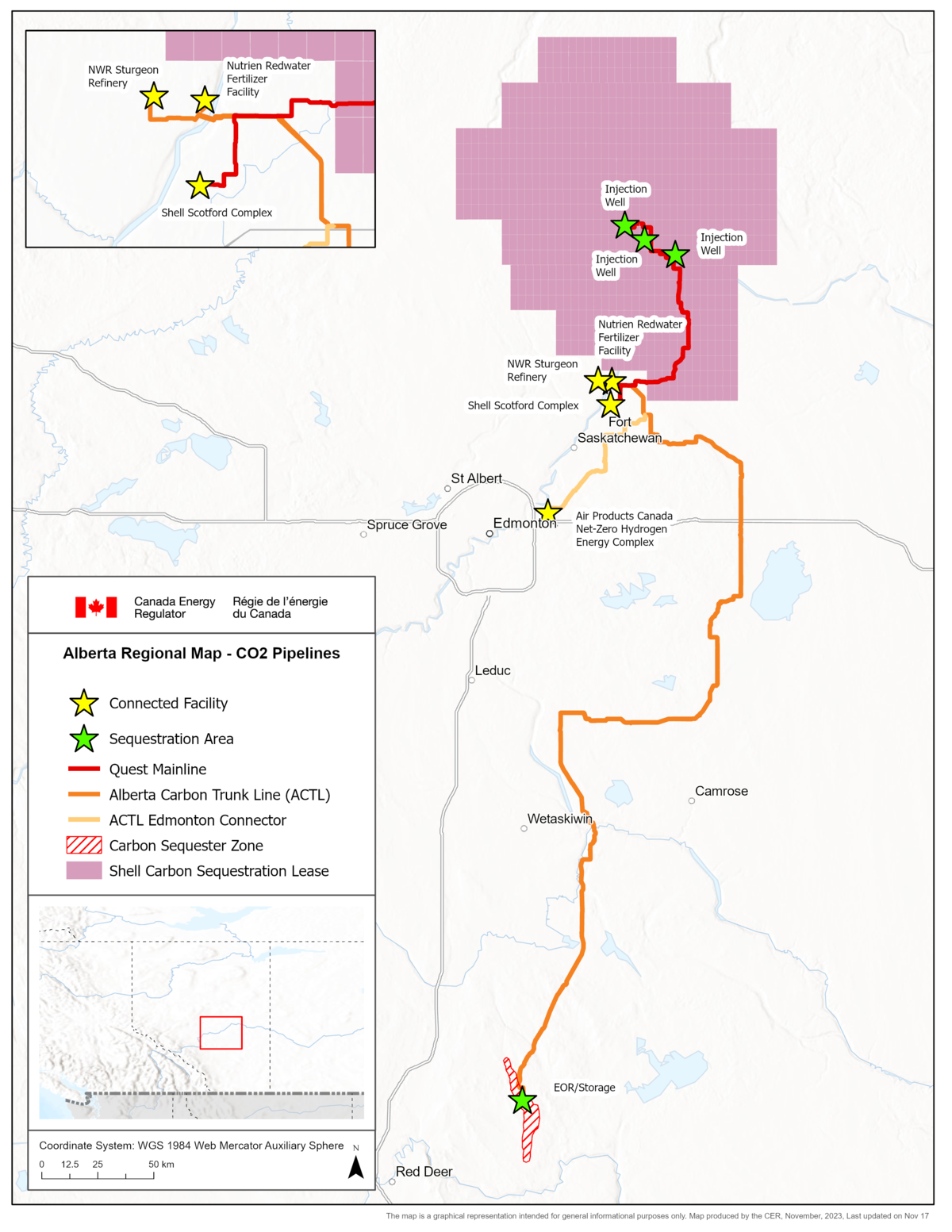Market Snapshot: Canada is expanding its CO2 pipeline network
Connect/Contact Us
Please send comments, questions, or suggestions for Market Snapshot topics to snapshots@cer-rec.gc.ca
Release date: 2024-05-01
In Canada, new carbon dioxide (CO2) pipeline projects are being announced. In September 2023, Wolf Midstream announced the expansion of its Alberta Carbon Trunk Line (ATCL) to Edmonton, AB. In Saskatchewan, Whitecap Resources stated it started engineering design of a new CO2 capture and pipeline project. However, both projects are adding capacity to an existing network of large CO2 pipelines that has been in operation for more than two decades. More projects could be expected in the future, as the development of carbon capture and storage (CCS)Definition* capacity is an essential part of the federal and provincial strategies to reduce emissions and transition to a low carbon future.
Carbon dioxide pipelines are an essential part of any carbon capture and storage project. Canada currently has five large CO2 pipeline systems. The Alberta Carbon Trunk LineFootnote 1 (ACTL), and the QuestFootnote 2 project pipelines are in Alberta, while the Boundary Dam to Weyburn, the Souris ValleyFootnote 3 and the Cardinal Energy Ltd.’s Midale CO2Footnote 4 pipelines are in south Saskatchewan (Table 1). Total capacity of these pipelines is estimated in 2023 at 7.1 million tonnes of CO2 per year (Mt CO2/year).
The Souris Valley pipelineFootnote 5—the oldest and largest—has been in service since 2000, the Midale pipeline since 2005 and the Boundary Dam pipeline since 2014. The Quest and ACTL pipelines became operational in 2015 and 2020, respectively. The Canada Energy Regulator (CER) regulates the Souris Valley pipeline, while Quest and ACTL are regulated by the Alberta Energy Regulator (AER)Footnote 6 and the Boundary Dam and Midale pipelines by the Saskatchewan provincial government.
Table 1: Major Canadian CO2 Pipelines
| Project | Start Up | Length (km) | Capacity (Mt CO2/y) | Start Point | End Point | Operator |
|---|---|---|---|---|---|---|
| Souris Valley PipelineTable Note a | 2000 | 61Table Note b | 3.0 | Canada - U.S. border | Near Weyburn, SK | Whitecap Resources |
| Cardinal Energy Midale CO2 pipelineTable Note c | 2005 | 25 | 0.3 | Near Weyburn, SK | Near Weyburn, SK | Cardinal Resources Ltd |
| Bounday Dam To Weyburn CO2 PipelineTable Note d | 2014 | 74 | 1.0 | Boundary Dam Power Plant, SK | Near Weyburn, SK | SaskPower, Whitecap Resources |
| Quest | 2015 | 64 | 1.2 | Scotford Upgrader, AB | Near Thornhill, AB | Shell Canada |
| Alberta Carbon Trunk Line (ACTL)Table Note e | 2020 | 240 | 1.6Table Note f 14.6Table Note g |
Sturgeon County, AB | Near Lacombe, AB | Wolf Midstream |
Sources
Sources: IEA, Shell, Wolf Midstream, Enhance Energy, Whitecap Resources, Cardinal Energy Ltd., MIT, SaskPower, National Geographic, CER.
Recently announced CO2 pipeline projects in Canada
Wolf Midstream, the operator of the ACTL announced in September 2023 that it received approval from the AER and started construction of the 3.0 Mt CO2/year ACTL Edmonton ConnectorFootnote 7. The new ATCL extension will initially transport CO2 produced at the Air Products’ Net Zero Hydrogen Energy Complex in Edmonton to the ACTL main line and would collect CO2 from other local industrial facilitiesFootnote 8, and be in service by the end of 2024.
In February 2023, Whitecap Resources announced the start of the front-end engineering and design (FEED) on a new major CO2 capture and pipeline project in Saskatchewan. The project would capture CO2 from several major CO2 emitters in the Regina and Moose Jaw area and transport it to Whitecap’s existing CO2-EOR facility near Weyburn. As of October 2023, Whitecap has secured five memoranda of understanding for capturing 1.2 to 3.0 MT CO2/year. If the final investment decision is taken in 2024, Whitecap expects to have the project onstream in 2025.Footnote 9Footnote 10
Support for the development of CCS infrastructure (including pipelines) has been provided at the federal and provincial level for over 15 years. In 2022 the federal government enacted Canada’s Carbon Management StrategyFootnote 11, and as part of Budget 2021 is investing $319 million over seven years to advance the commercial viability of carbon capture utilization and storage (CCUS) technologies through its Energy Innovation ProgramFootnote 12, between other programs and policiesFootnote 13. Alberta has enacted a regulatory framework for CCS development and implemented support initiatives for CCS. Also, in November 2021 the Government of Saskatchewan announced that pipelines transporting CO2 are now eligible for support through the provincial Oil Infrastructure Investment ProgramFootnote 14.
Alberta is leading development in CCS projects in Canada, with six projects in service and 25 new projects under evaluation. These projects would require either new CO2 pipelines or expansion of the existing ones to transport the expected vast volumes of CO2 that would be captured and transported for storage in the province.
Figure 1: Saskatchewan Major CO2 Pipelines
Sources and Description
Sources: WhiteCap Resources, Cardinal Energy, IEA, CER
Description: The Souris Valley pipeline (orange line) runs from the Canada-U.S. border to a terminal near Goodwater, SK, where the CO2 is injected in the Weyburn-Midale oil field for enhanced oil recovery. The Souris Valley pipeline is connected to Dakota Gasification Company (DGC) pipeline, which transports CO2 captured at the DGC’s plant near Beulah, North Dakota to the Canada-U.S. border. The Whitecap Resources Boundary Dam CO2 pipeline (green line) transports CO2 captured at SaskPower’s Boundary Dam power plant to the Aquistore CO2 Sequestration Project and to the Weyburn oil field. The Cardinal Energy Midale CO2 Pipeline (purple line) transports CO2 from the terminus of the Souris Valley pipeline to the Midale oil field.
Figure 2: Alberta Major CO2 Pipelines
Sources and Description
Sources: Wolf Midstream, Shell, Enhance Energy, Daily Oil Bulletin, CER
Description: This map shows the route of the CO2 pipeline of the Quest CCS project and the Alberta Carbon Trunk Line (ATCL). The Quest pipeline (brown line) transports CO2 captured at the Scotford upgrader in the oil sands area to three CO2 sequestration wells near Thornhill, AB, where the CO2 is injected in a deep saline reservoir. The ATCL (orange line) connects the Sturgeon Refinery, and the Nutrien’s Redwater Fertilizer plant, both northeast of Edmonton, to oil fields where the CO2 is sequestered near Clive, AB. The ACTL’s Edmonton Connector (light orange line) is planned to connect ACTL to the Air Products’ Blue Hydrogen plant near Edmonton, AB.
- Date modified:


